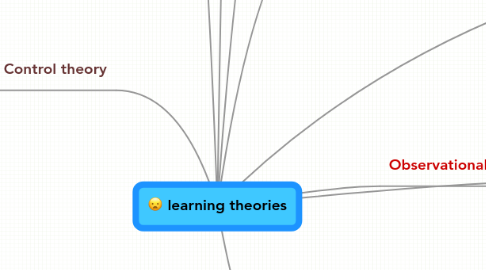
1. Learning style
1.1. active
1.2. concrete
1.3. abstract
1.4. reflective
1.5. psychology
1.5.1. visual learner
1.5.1.1. seeing
1.5.1.1.1. picture
1.5.1.1.2. flash card
1.5.1.1.3. mindmaping
1.5.1.1.4. mental picture
1.5.2. audithory learner
1.5.2.1. hearing
1.5.2.1.1. tape record
1.5.2.1.2. discussion
1.5.2.1.3. read
1.5.3. kinesthetic learner
1.5.3.1. use
1.5.3.1.1. practice test
1.5.3.1.2. discussion
1.6. impact
1.6.1. curriculum
1.6.1.1. intutition
1.6.1.2. sensing
1.6.1.3. feeling
1.6.1.4. imagination
1.6.2. instruction
1.6.2.1. combination of various experiental elements
1.6.2.1.1. sound
1.6.2.1.2. music
1.6.2.1.3. movement
1.6.3. assessment
1.6.3.1. focusing on the "whole brain"
2. Control theory
2.1. motivation
2.1.1. survival
2.1.2. love
2.1.3. power
2.1.4. freedom
2.1.5. other basic human needs
2.2. assumption
2.2.1. control of behaviour
2.2.2. maximizing the satisfaction
2.3. teaching methods
2.3.1. clear rules
2.3.1.1. reward
2.3.1.2. punishment
2.4. learning style
2.4.1. curriculum
2.4.1.1. negotiation between students and teachers
2.4.1.1.1. how to teach
2.4.1.1.2. what to teach
2.4.2. instruction
2.4.2.1. cooperative learning techniques
2.4.2.2. active learning techniques
2.4.2.3. students' satisfaction
2.4.3. assessment
2.4.3.1. absolute standard
2.4.3.2. no curves
3. "Social learning theory"
3.1. symnopsis
3.1.1. imitation of models
3.1.1.1. talent
3.1.1.2. intelligence
3.1.1.3. good looks
3.1.1.4. power
3.1.1.5. popularity
3.1.2. acquisition of behaviour without performace
3.1.3. production of the rewarded behaviour
3.1.4. processes of learning a behaviour
3.1.4.1. attention
3.1.4.2. production
3.1.4.3. motivation
3.2. learning style
3.2.1. curriculum
3.2.1.1. observation of a model
3.2.1.2. positive reinforcement
3.2.2. instruction
3.2.2.1. collaborative learning
3.2.3. assessment
3.2.3.1. right environment
3.2.3.1.1. incentive
3.2.3.1.2. supportive
4. retention
5. behaviourist
5.1. classical conditioning
5.1.1. stimulus & response
5.1.2. Pavlov
5.2. operant conditioning
5.2.1. positive & negative reinforcement
5.2.2. B F Skinner
6. Multiple Intelligence
6.1. 7 intelligence
6.1.1. verbal linguistic
6.1.2. logical mathematical
6.1.3. visual spatial
6.1.4. body kinesthetic
6.1.5. musical ryhthmic
6.1.6. interpersonal
6.1.7. intrapersonal
6.2. curriculum
6.2.1. balanced
6.3. instruction
6.3.1. address all intelligence
6.4. assessment
6.4.1. measure all forms of intelligence
7. Developmental
7.1. 4 stages
7.1.1. Senorimotor (birth-2 yrs)
7.1.2. concrete operations (7-11 yrs)
7.1.3. preoperational (2-7 yrs)
7.1.4. formal operations (11-15 yrs > audlt)
7.2. 7 principles cognitive structure
7.2.1. scheme
7.3. curriculum
7.3.1. developmental
8. Observational Learning
9. Connectionism
9.1. 3 primary laws
9.1.1. law of effect
9.1.1.1. rewarding state of affairs
9.1.1.1.1. habitual responses
9.1.2. law of readiness
9.1.2.1. blocking a chain of responses for achieving goal
9.1.2.1.1. annoyance
9.1.3. law of exercise
9.1.3.1. more practices
9.1.3.1.1. strengthening connections
9.2. transfer of learning
9.2.1. identical elements in new and old environments
